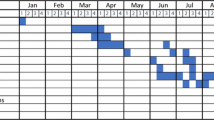Abstract
Faced with the opportunity to significantly deviate from classic operations, a new emergency department (ED) and novel strategy for patient care delivery were simultaneously initiated with the aid of model-based simulation. To answer the design and implementation questions, a traditional strategy for construction of discrete-eventmodel simulation was employed to define ED operations for a newly constructed facility in terms of workflow, variables, resources, structure, process logic and associated assumptions. Benefits were achieved before, during and after implementation of an unprecedented operations strategy—i.e., the organization of the ED care delivery around four care streams: Critical, Diagnostic, Therapeutic and Fast Track. Prior to opening, it shed light on the range of context variables where benefits might be anticipated, and it facilitated staff understanding and judgements of performance. Two years after opening, the operations data is compared to the simulation with encouraging results that shed light on where to continue pursuit of improvement.




Similar content being viewed by others
References
Iyer, S., Reeves, S., Varadarajan, K., and Alessandrini, E., The acute care model: A new framework for quality care in emergency medicine. Clin. Pediatr. Emerg. Med. 12(2):91–101, 2011.
Devapriya, P., Stromblad, C.T., Bailey, M.D., Frazier, S., Bulger, J., Kemberling, S.T., and Wood, K.E., StratBAM: A discrete-event simulation model to support strategic hospital bed capacity decisions. J. Med. Syst. 39(10):130, 2015. https://doi.org/10.1007/s10916-015-0325-0.
Kolker, A., Process modeling of ICU patient flow: Effect of daily load leveling of elective surgeries on ICU diversion. J. Med. Syst. 33(1):27–40, 2009.
Bair, A.E., Song, W.T., Chen, Y.C., and Morris, B.A., The impact of inpatient boarding on ED efficiency: A discrete-event simulation study. J. Med. Syst. 34(5):919–929, 2010. https://doi.org/10.1007/s10916-009-9307-4.
Marshall, A., Vasilakis, C., and El-Darzi, E., Length of stay-based patient flow models: Recent developments and future directions. Health Care Manag. Sci. 8(3):213–220, 2005.
Kolker, A., Process modeling of emergency department patient flow: Effect of patient length of stay on ED diversion. J. Med. Syst. 32(5):389–401, 2008.
Karnon, J., Stahl, J., Brennan, A., Caro, J.J., Mar, J., and Moller, J., Modeling using discrete event simulation: A report of the ISPOR-SMDM modeling good research practices task force-4. Med. Decis. Mak. 32(5):701–711, 2012. https://doi.org/10.1177/0272989X12455462.
McHugh, M., Tanabe, P., McClelland, M., and Khare, R.K., More patients are triaged using the emergency severity index than any other triage acuity system in the United States. Acad. Emerg. Med. 19(1):106–109, 2012. https://doi.org/10.1111/j.1553-2712.2011.01240.x.
Tanabe, P., Gimbel, R., Yarnold, P.R., and Adams, J.G., The emergency severity index (version 3) 5-level triage system scores predict ED resource consumption. J. Emerg. Nurs. 30(1):22–29, 2004. https://doi.org/10.1016/j.jen.2003.11.004.
Wuerz, R.C., Travers, D., Gilboy, N., Eitel, D.R., Rosenau, A., and Yazhari, R., Implementation and refinement of the emergency severity index. Acad. Emerg. Med. 8(2):170–176, 2001.
Wang, L., Zhou, H., and Zhu, J.F., Application of emergency severity index in pediatric emergency department. World J Emerg Med. 2(4):279–282, 2011. https://doi.org/10.5847/wjem.j.1920-8642.2011.04.006.
Palvannan, R.K., and Teow, K.L., Queueing for healthcare. J. Med. Syst. 36(2):541–547, 2012. https://doi.org/10.1007/s10916-010-9499-7.
Cross, K.P., Gracely, E., Stevenson, M.D., and Woods, C.R., Identifying key metrics for reducing premature departure from the pediatric emergency department. Acad. Emerg. Med. 17(11):1197–1206, 2010. https://doi.org/10.1111/j.1553-2712.2010.00908.x.
Day, T.E., Al-Roubaie, A.R., and Goldlust, E.J., Decreased length of stay after addition of healthcare provider in emergency department triage: A comparison between computer-simulated and real-world interventions. Emerg. Med. J., 2012. https://doi.org/10.1136/emermed-2012-201113.
Kocher, K.E., Meurer, W.J., Desmond, J.S., and Nallamothu, B.K., Effect of testing and treatment on emergency department length of stay using a national database. Acad. Emerg. Med. 19(5):525–534, 2012. https://doi.org/10.1111/j.1553-2712.2012.01353.x.
McCarthy, M.L., Zeger, S.L., Ding, R., Levin, S.R., Desmond, J.S., Lee, J., and Aronsky, D., Crowding delays treatment and lengthens emergency department length of stay, even among high-acuity patients. Ann. Emerg. Med. 54(4):492–503 e494, 2009. https://doi.org/10.1016/j.annemergmed.2009.03.006.
O'Mahony, L., O'Mahony, D.S., Simon, T.D., Neff, J., Klein, E.J., and Quan, L., Medical complexity and pediatric emergency department and inpatient utilization. Pediatrics. 131(2):e559–e565, 2013. https://doi.org/10.1542/peds.2012-1455.
Shaw, K.N., Ruddy, R.M., and Gorelick, M.H., Pediatric emergency department directors' benchmarking survey: Fiscal year 2001. Pediatr. Emerg. Care. 19(3):143–147, 2003. https://doi.org/10.1097/01.pec.0000081233.20228.fd.
National Hospital Ambulatory Medical Care Survey (2010). ftp://ftp.cdc.gov/pub/Health_Statistics/NCHS/Datasets/NHAMCS/
Premier (2006) Emergency department benchmarks and best practices - a report of the premier ED survey findings. Premier.
Author information
Authors and Affiliations
Corresponding author
Ethics declarations
Conflict of Interest
Duane Steward declares that he has no conflict of interest. Todd Glass declares that he has no conflict of interest. Yann Ferrand declares that he has no conflict of interest.
Ethical Approval
This article does not contain any studies with human participants or animals performed by any of the authors.
Additional information
This article is part of the Topical Collection on Systems-Level Quality Improvement
Rights and permissions
About this article
Cite this article
Steward, D., Glass, T.F. & Ferrand, Y.B. Simulation-Based Design of ED Operations with Care Streams to Optimize Care Delivery and Reduce Length of Stay in the Emergency Department. J Med Syst 41, 162 (2017). https://doi.org/10.1007/s10916-017-0804-6
Received:
Accepted:
Published:
DOI: https://doi.org/10.1007/s10916-017-0804-6




